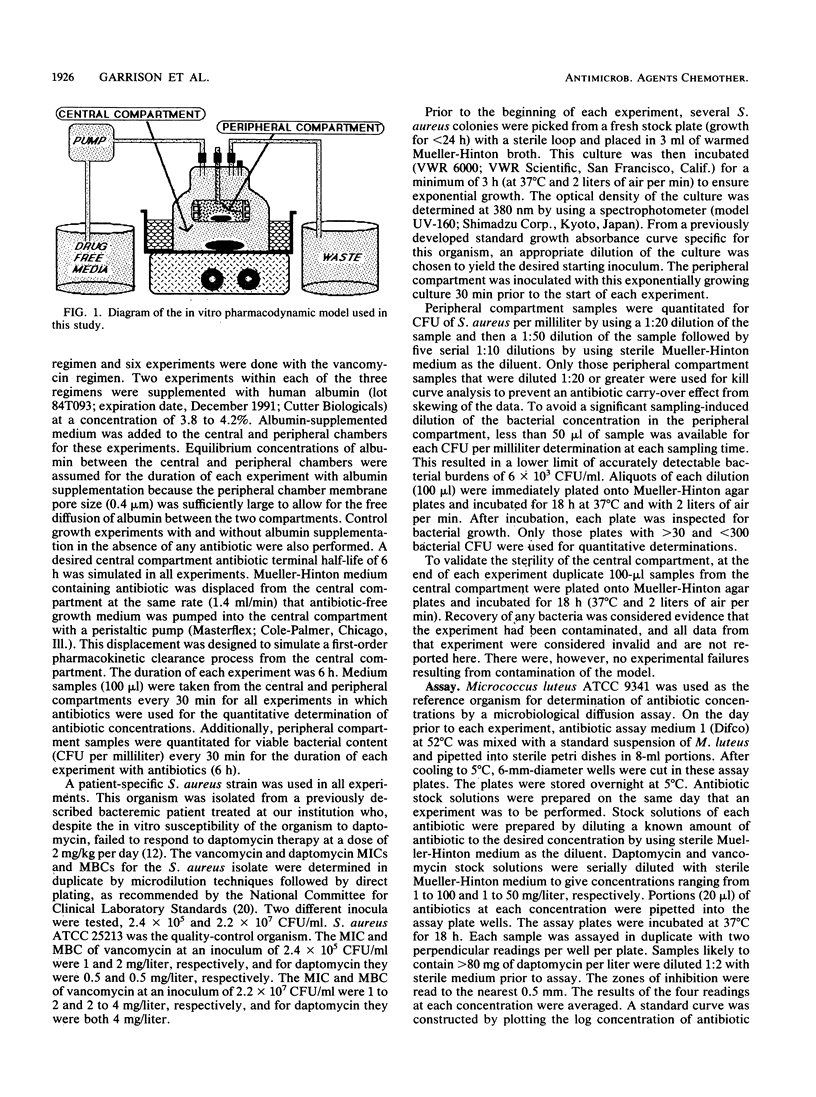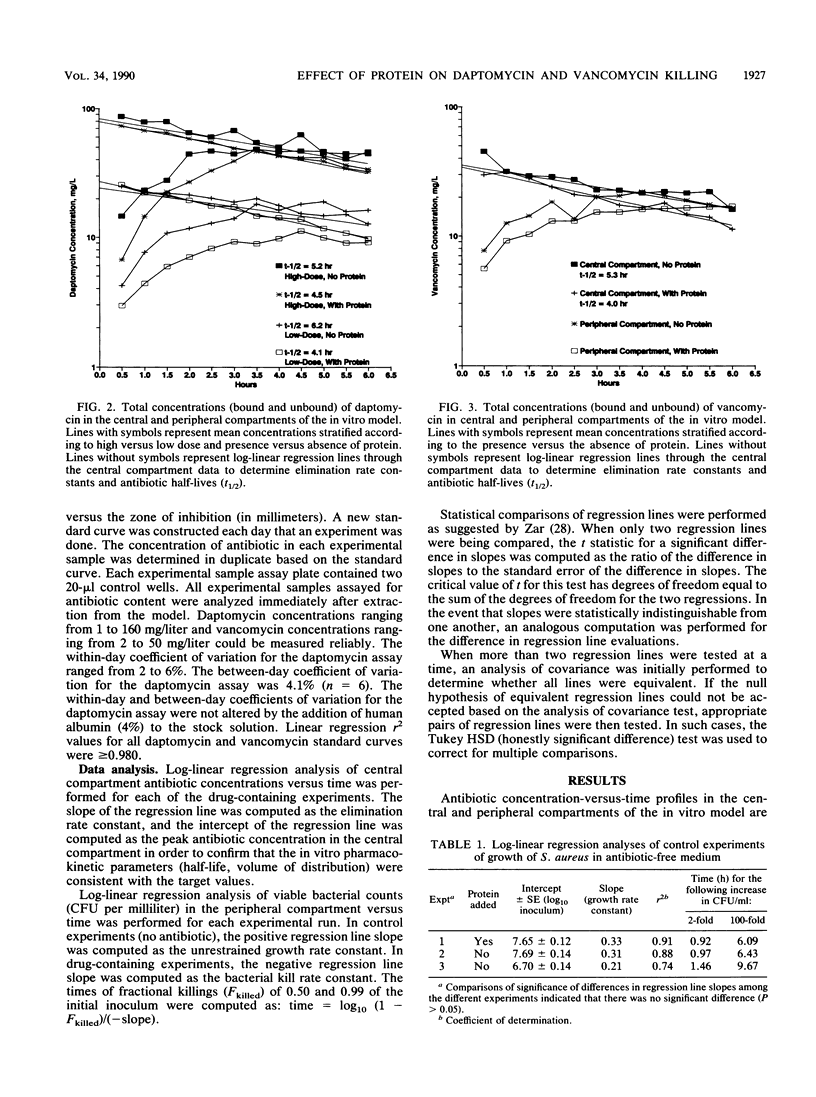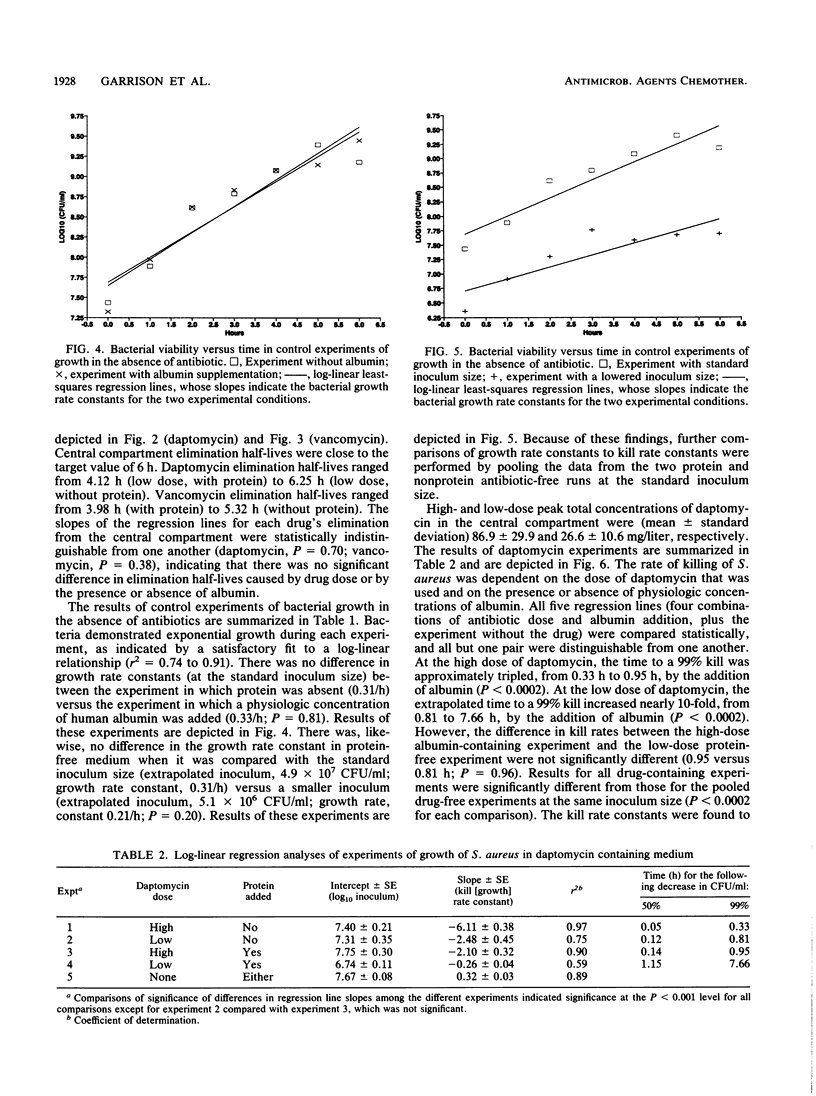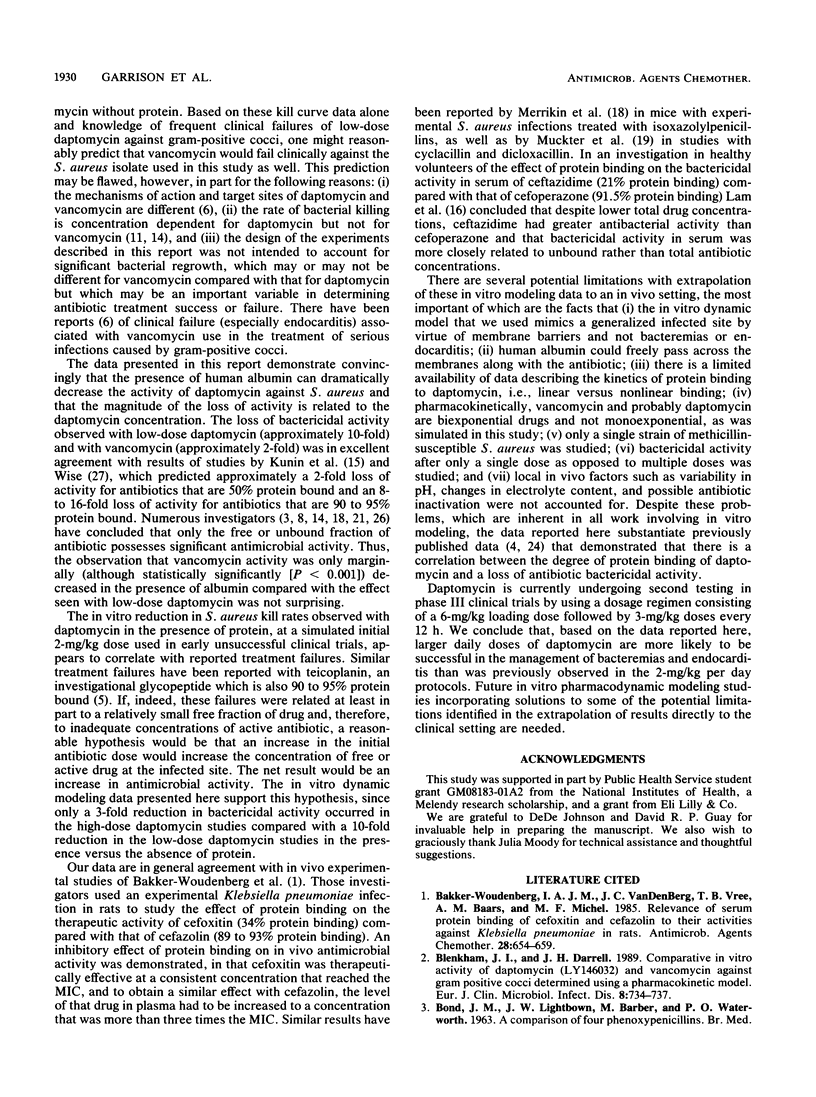Abstract
Initial clinical trials with daptomycin (2 mg/kg per day) were prematurely suspended because of unexplained treatment failures in patients with bacteremia who were treated with daptomycin, despite in vitro data indicating that the gram-positive cocci causing the infection were susceptible to daptomycin. One explanation for these clinical failures may relate to the relatively high degree of daptomycin protein binding (94%). To evaluate the impact of protein on daptomycin activity, a two-chamber in vitro pharmacodynamic model was used to study and compare the interaction between Staphylococcus aureus (clinical isolate) and either daptomycin or vancomycin, each in the presence and absence of physiologic human albumin concentrations. Low-dose (2 mg/kg) daptomycin, high-dose (6 mg/kg) daptomycin, and 10 mg of vancomycin per kg beta-phase elimination serum-concentration-versus-time curves were simulated by using this in vitro pharmacodynamic model. The bacterial kill rates by all three regimens were decreased in the presence of albumin (P less than 0.0002). The average times required for a 99% kill of the initial S. aureus inocula (approximately 5 x 10(7) CFU/ml) without albumin were 0.81 (low-dose daptomycin), 0.33 (high-dose daptomycin), and 6.18 (vancomycin) h. The average times required for a 99% kill of S. aureus with albumin were 7.66 (low-dose daptomycin), 0.95 (high-dose daptomycin), and 10.52 (vancomycin) h. These data demonstrate that, depending on the concentration of daptomycin, the presence of albumin can profoundly diminish the bactericidal activity of daptomycin.
Full text
PDF






Selected References
These references are in PubMed. This may not be the complete list of references from this article.
- Bakker-Woudenberg I. A., van den Berg J. C., Vree T. B., Baars A. M., Michel M. F. Relevance of serum protein binding of cefoxitin and cefazolin to their activities against Klebsiella pneumoniae pneumonia in rats. Antimicrob Agents Chemother. 1985 Nov;28(5):654–659. doi: 10.1128/aac.28.5.654. [DOI] [PMC free article] [PubMed] [Google Scholar]
- Blenkharn J. I., Darrell J. H. Comparative in vitro activity of daptomycin (LY146032) and vancomycin against gram-positive cocci determined using a pharmacokinetic model. Eur J Clin Microbiol Infect Dis. 1989 Aug;8(8):734–737. doi: 10.1007/BF01963764. [DOI] [PubMed] [Google Scholar]
- Bush L. M., Boscia J. A., Kaye D. Daptomycin (LY146032) treatment of experimental enterococcal endocarditis. Antimicrob Agents Chemother. 1988 Jun;32(6):877–881. doi: 10.1128/aac.32.6.877. [DOI] [PMC free article] [PubMed] [Google Scholar]
- Calain P., Krause K. H., Vaudaux P., Auckenthaler R., Lew D., Waldvogel F., Hirschel B. Early termination of a prospective, randomized trial comparing teicoplanin and flucloxacillin for treating severe staphylococcal infections. J Infect Dis. 1987 Feb;155(2):187–191. doi: 10.1093/infdis/155.2.187. [DOI] [PubMed] [Google Scholar]
- Canepari P., Boaretti M., Lleó M. M., Satta G. Lipoteichoic acid as a new target for activity of antibiotics: mode of action of daptomycin (LY146032). Antimicrob Agents Chemother. 1990 Jun;34(6):1220–1226. doi: 10.1128/aac.34.6.1220. [DOI] [PMC free article] [PubMed] [Google Scholar]
- Chambers H. F., Mills J., Drake T. A., Sande M. A. Failure of a once-daily regimen of cefonicid for treatment of endocarditis due to Staphylococcus aureus. Rev Infect Dis. 1984 Nov-Dec;6 (Suppl 4):S870–S874. doi: 10.1093/clinids/6.supplement_4.s870. [DOI] [PubMed] [Google Scholar]
- Eliopoulos G. M., Willey S., Reiszner E., Spitzer P. G., Caputo G., Moellering R. C., Jr In vitro and in vivo activity of LY 146032, a new cyclic lipopeptide antibiotic. Antimicrob Agents Chemother. 1986 Oct;30(4):532–535. doi: 10.1128/aac.30.4.532. [DOI] [PMC free article] [PubMed] [Google Scholar]
- Fass R. J., Helsel V. L. In vitro activity of LY146032 against staphylococci, streptococci, and enterococci. Antimicrob Agents Chemother. 1986 Nov;30(5):781–784. doi: 10.1128/aac.30.5.781. [DOI] [PMC free article] [PubMed] [Google Scholar]
- Flandrois J. P., Fardel G., Carret G. Early stages of in vitro killing curve of LY146032 and vancomycin for Staphylococcus aureus. Antimicrob Agents Chemother. 1988 Apr;32(4):454–457. doi: 10.1128/aac.32.4.454. [DOI] [PMC free article] [PubMed] [Google Scholar]
- Garrison M. W., Rotschafer J. C., Crossley K. B. Suboptimal effect of daptomycin in the treatment of bacteremias. South Med J. 1989 Nov;82(11):1414–1415. doi: 10.1097/00007611-198911000-00018. [DOI] [PubMed] [Google Scholar]
- Jones R. N., Barry A. L. Antimicrobial activity and spectrum of LY146032, a lipopeptide antibiotic, including susceptibility testing recommendations. Antimicrob Agents Chemother. 1987 Apr;31(4):625–629. doi: 10.1128/aac.31.4.625. [DOI] [PMC free article] [PubMed] [Google Scholar]
- Kunin C. M. Clinical pharmacology of the new penicillins. 1. The importance of serum protein binding in determining antimicrobial activity and concentration in serum. Clin Pharmacol Ther. 1966 Mar-Apr;7(2):166–179. doi: 10.1002/cpt196672166. [DOI] [PubMed] [Google Scholar]
- Kunin C. M., Craig W. A., Kornguth M., Monson R. Influence of binding on the pharmacologic activity of antibiotics. Ann N Y Acad Sci. 1973 Nov 26;226:214–224. doi: 10.1111/j.1749-6632.1973.tb20483.x. [DOI] [PubMed] [Google Scholar]
- Lam Y. W., Duroux M. H., Gambertoglio J. G., Barriere S. L., Guglielmo B. J. Effect of protein binding on serum bactericidal activities of ceftazidime and cefoperazone in healthy volunteers. Antimicrob Agents Chemother. 1988 Mar;32(3):298–302. doi: 10.1128/aac.32.3.298. [DOI] [PMC free article] [PubMed] [Google Scholar]
- Lang S. D., Cameron G. L., Mullins P. R. Anomalous effect of serum on the antimicrobial activity of cefoperazone. Drugs. 1981;22 (Suppl 1):52–59. doi: 10.2165/00003495-198100221-00012. [DOI] [PubMed] [Google Scholar]
- Merrikin D. J., Briant J., Rolinson G. N. Effect of protein binding on antibiotic activity in vivo. J Antimicrob Chemother. 1983 Mar;11(3):233–238. doi: 10.1093/jac/11.3.233. [DOI] [PubMed] [Google Scholar]
- Mückter H., Sous H., Poszich G., Arend P. Comparative studies of the activity of ciclacillin and dicloxacillin. Chemotherapy. 1976;22(3-4):183–189. doi: 10.1159/000221925. [DOI] [PubMed] [Google Scholar]
- Peterson L. R., Gerding D. N. Influence of protein binding of antibiotics on serum pharmacokinetics and extravascular penetration: clinically useful concepts. Rev Infect Dis. 1980 May-Jun;2(3):340–348. doi: 10.1093/clinids/2.3.340. [DOI] [PubMed] [Google Scholar]
- Rolinson G. N., Sutherland R. The binding of antibiotics to serum proteins. Br J Pharmacol Chemother. 1965 Dec;25(3):638–650. doi: 10.1111/j.1476-5381.1965.tb01788.x. [DOI] [PMC free article] [PubMed] [Google Scholar]
- Stratton C. W., Liu C., Ratner H. B., Weeks L. S. Bactericidal activity of deptomycin (LY146032) compared with those of ciprofloxacin, vancomycin, and ampicillin against enterococci as determined by kill-kinetic studies. Antimicrob Agents Chemother. 1987 Jul;31(7):1014–1016. doi: 10.1128/aac.31.7.1014. [DOI] [PMC free article] [PubMed] [Google Scholar]
- Van der Auwera P. Ex vivo study of serum bactericidal titers and killing rates of daptomycin (LY146032) combined or not combined with amikacin compared with those of vancomycin. Antimicrob Agents Chemother. 1989 Oct;33(10):1783–1790. doi: 10.1128/aac.33.10.1783. [DOI] [PMC free article] [PubMed] [Google Scholar]
- Verbist L. In vitro activity of LY146032, a new lipopeptide antibiotic, against gram-positive cocci. Antimicrob Agents Chemother. 1987 Feb;31(2):340–342. doi: 10.1128/aac.31.2.340. [DOI] [PMC free article] [PubMed] [Google Scholar]
- Wise R. Protein binding of beta-lactams: the effects on activity and pharmacology particularly tissue penetration. I. J Antimicrob Chemother. 1983 Jul;12(1):1–18. doi: 10.1093/jac/12.1.1. [DOI] [PubMed] [Google Scholar]
- Wise R. The relevance of pharmacokinetics to in-vitro models: protein binding--does it matter? J Antimicrob Chemother. 1985 Jan;15 (Suppl A):77–83. doi: 10.1093/jac/15.suppl_a.77. [DOI] [PubMed] [Google Scholar]


